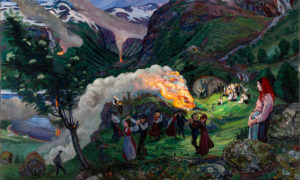The longest day has come and gone, and here we are, on its heels, with an old celebration known as Midsummer. The opposite spoke of the wheel from Yuletide, Midsummer tends to get short shrift here in the States. But if we look at our Wheel of the Year, and if we were to place the two solstices at the poles, top and bottom, one would be the June solstice and the other would be the December solstice. For us here in the Northern Hemisphere, the June solstice brings summer, and the December solstice, winter. Our ancestors called these Midsummer and Midwinter, and with good reason: for Midsummer, light increases daily up until the solstice, and then begins to diminish. And of course the opposite happens with Midwinter: darkness increases daily up until the solstice, and then begins to diminish. It’s the Constant Rearrange we talk about, each day slightly different than the one before and the one to come.
The early Church chose these highly metaphoric celestial events as the birth dates of Jesus and his cousin, John the Baptist. No one knows, of course, when these two historic figures were actually born. But how powerful, no, to place the birth of Jesus at Midwinter and the birth of St. John at Midsummer. St. John brings shortening days each year, and John himself tells us something to the effect of, “I must decrease so he may increase.” John prepares the way for Jesus. Six months later, we reach the opposite spoke in our wheel, and there we celebrate the birth of Christ, at the time of our darkest days, our longest nights… just as sunlight begins again its increase. Hence the old hymn, “Jesus, the Light of the World“.
Transitional periods like this in our wheel have long been considered magical times, too. We know all about Christmas Eve magic (ask any young child and perhaps the young-at-heart, too). St. John’s Eve has a healthy dose of this, as well. William Shakespeare set his comedy, A Midsummer Night’s Dream, on this night. Talk about magic and mayhem. This is a wonderful time of year to read Shakespeare’s play, or to watch one of the film versions. It’s also a wonderful time of year to be outdoors in the twilight as our longest days transition to our shortest nights. Happy Midsummer.
COME SEE US AT THE SHOP!
We’ve got Kim Spivey teaching a new session of Collagraph Printmaking on Sunday July 27. Kim’s a great teacher and this is a wonderful class… it’s the second time she’s teaching it for us this year. Come learn something new!
Image: “Midsummer Eve Bonfire” by Nikolai Astrup. Painting, 1915. [Public domain] via Wikimedia Commons.


A Happy Midsummer to all! And don’t forget to leap over the St. John’s Eve bonfire—though do be sure it’s suitably low and small. No need to be as daring as our ancestors!
Be careful!
Happy Midsummer and thank you for this beautiful post! I’m going to try to make an oak leaf wreath this afternoon for my door, and also drink mead tonight honor of this special tine of year! If you’re outside in late twilight tonight, look at the bright star Arcturus, almost at the Zenith. It starts rising in the spring, and it disappears in late October as the Ghost of the Summer Sun. Quite fitting it is at the Zenith, and crossing the meridian at dark on Midsummer!
Oh that sounds lovely, Mary Beth. And mead is very fitting, as St. John is another patron saint of beekeepers. I’ll look for your star tonight.
John, I just saw your comment on my post about Old Midsummer. Here is the website that I used to find out about it. It coincides with Saint Barnaby’s day.. I love it because it gives me two different occasions to celebrate! And I love how it’s associated with the hay harvest, which has a Summery, yet also a bit Autumny!
https://discover.hubpages.com/education/StBarnabas-and-Old-Midsummer
Thank you for the details, MB, on Old Midsummer. When I read your comment in the post a few weeks ago, I had a feeling it might have something to do with the shift in calendars and Britain taking so long to adopt the shift.
As someone who has done plenty of hay-gathering (it was part and parcel of all my internships at the Shaker Press at the Sabbathday Lake Shaker Community in Maine), I can attest to the sweet scent of freshly gathered hay and the satisfaction of seeing bales of it stacked in the barn. I’d usually end up with a sinus headache afterward, but still… even this was a bit magical. The Shaker’s barn is majestic and, to me, at least, always feels like a bit of a cathedral of nature, to be in there with the soaring wooden ceilings and the sounds of the sheep.
Thank you for sharing more about your celebrations.